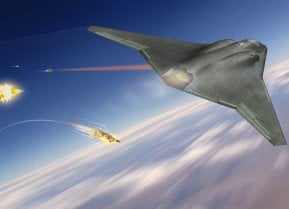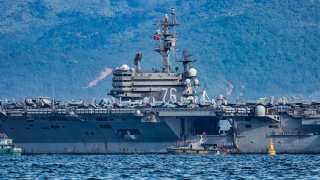What Makes Nimitz-Class Aircraft Carrier USS Ronald Reagan Unforgettable
The USS Ronald Reagan (CVN-76), a Nimitz-class aircraft carrier named after the 40th president, has departed Yokosuka, Japan, for its final Indo-Pacific patrol before returning to the United States. Accompanied by the USS Robert Smalls (CG-62) and USS Howard (DDG-83), the carrier leaves after nearly nine years of deployment.
Summary: The USS Ronald Reagan (CVN-76), a Nimitz-class aircraft carrier named after the 40th president, has departed Yokosuka, Japan, for its final Indo-Pacific patrol before returning to the United States. Accompanied by the USS Robert Smalls (CG-62) and USS Howard (DDG-83), the carrier leaves after nearly nine years of deployment.
Key Points and Information You Need To Know
-Dignitaries, including the U.S. ambassador to Japan and Japanese officials, attended the departure.
-The USS Ronald Reagan has been the flagship of Carrier Strike Group 5 and has participated in numerous exercises and humanitarian missions. It will be replaced by the USS George Washington (CVN-73) as the forward-deployed carrier.
USS Ronald Reagan Begins Final Indo-Pacific Patrol Before Returning to the US
The United States Navy’s Nimitz-class aircraft carrier USS Ronald Reagan (CVN-76), named in honor of the fortieth president of the United States, along with its carrier strike group (CSG), departed Yokosuka, Japan, on Thursday. The Ronald Reagan began its final Indo-Pacific patrol as the Forward Deployed Naval Force-Japan (FDNF-J) aircraft carrier before it returns to the United States later this year.
The nuclear-powered supercarrier left Yokosuka on Thursday, accompanied by the Ticonderoga-class cruiser USS Robert Smalls (CG-62) and Arleigh Burke-class destroyer USS Howard (DDG-83).
According to a release from the U.S. Navy’s 7th Fleet, dignitaries including the U.S. ambassador to Japan, Japanese government officials, and officers from the U.S. Navy and Japan Maritime Self-Defense Force (JMSDF) attended the event to send off CVN-76 as the vessel departed Japan for the final time.
“We have a debate in the United States about who constitutes the 1 percent. The true measure is not in how much wealth you acquire, but in how much you give in service to something bigger than yourself,” Ambassador Rahm Emanuel said in the statement. “So, to the sailors and aviators of the USS Ronald Reagan, who devote their lives to preserving and protecting the freedoms we all enjoy, it is you and your fellow service members who make up America’s true 1 percent. After nine years of deployment to Japan, the USS Ronald Reagan and her 6,000 crew deserve our heartfelt appreciation for their selflessness, their service, and their sacrifice in keeping the Indo-Pacific safe, secure, and stable.”
Big in Japan: A Nine-Year Forward Deployment
The USS Ronald Reagan first arrived in Yokosuka, Japan, in 2015, and served as the flagship of Carrier Strike Group 5 (CSG-5) under the U.S. Navy’s 7th Fleet. As the U.S. Navy’s only forward-deployed aircraft carrier, CVN-76 took part in dozens of multilateral exercises and made port-of-call visits to numerous foreign ports. That included a historic visit to Da Nang, Vietnam, in 2023—only the third time a U.S. Navy carrier had visited the country since the Vietnam War.
During an earlier deployment to the Indo-Pacific, CVN-76 provided humanitarian aid as part of Operation Tomodachi, following the devastating 2011 earthquake, tsunami, and subsequent nuclear disaster that impacted northeastern Japan.
By federal law—10 U.S. Code § 8690—the overseas forward deployment of naval vessels is strictly limited to ten years, and following that period of overseas deployment, the vessels must be assigned a homeport in the United States. CVN-76 is now scheduled to head to Bremerton, Washington, later this year.
“For nearly nine years, thousands of Ronald Reagan Sailors have lived and worked here in Yokosuka, and have deployed throughout the region to uphold the international rule of law and maintain a free and open Indo-Pacific along with our allies and partners,” said Capt. Daryle Cardone, the Ronald Reagan’s commanding officer. “And as forward-deployed naval forces, we had the privilege of living in Japan. Japan has been an incredible host and a second home for the crew. And for this, I am very grateful to the Japanese people, the City of Yokosuka, and the Japanese government for their support and for welcoming us as citizens.”
The USS George Washington (CVN 73), which last May completed its four-year Refueling and Complex Overhaul (RCOH) that began in 2017, will replace CVN-76 as the U.S. Navy’s forward-deployed carrier. In 2008, CVN-73 became the first nuclear-powered forward-deployed carrier homeported at the U.S. Yokosuka Naval Base, Japan, replacing the conventionally-powered USS Kitty Hawk (CV-63).
About the Author: Peter Suciu
Peter Suciu is a Michigan-based writer. He has contributed to more than four dozen magazines, newspapers, and websites with over 3,200 published pieces over a twenty-year career in journalism. He regularly writes about military hardware, firearms history, cybersecurity, politics, and international affairs. Peter is also a Contributing Writer for Forbes and Clearance Jobs. You can follow him on Twitter: @PeterSuciu. You can email the author: [email protected].


